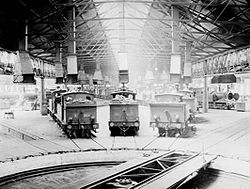
North Melbourne Locomotive Depot
Encyclopedia

Victorian Railways
The Victorian Railways operated railways in the Australian state of Victoria from 1859 to 1983. The first railways in Victoria were private companies, but when these companies failed or defaulted, the Victorian Railways was established to take over their operations...
steam locomotive
Steam locomotive
A steam locomotive is a railway locomotive that produces its power through a steam engine. These locomotives are fueled by burning some combustible material, usually coal, wood or oil, to produce steam in a boiler, which drives the steam engine...
fleet based in Melbourne
Melbourne
Melbourne is the capital and most populous city in the state of Victoria, and the second most populous city in Australia. The Melbourne City Centre is the hub of the greater metropolitan area and the Census statistical division—of which "Melbourne" is the common name. As of June 2009, the greater...
. Located in the middle of the Melbourne Yard precinct in the suburb West Melbourne
West Melbourne, Victoria
West Melbourne is an inner city suburb of Melbourne, Victoria, Australia, 3 km north-west from Melbourne's central business district. Its Local Government Area is the City of Melbourne...
near North Melbourne railway station
North Melbourne railway station
North Melbourne is a railway station located on the northern edge of the central business district of Melbourne, Australia. The station is the point through which pass the west and north-west bound Craigieburn, Flemington Racecourse, Sydenham, Upfield, Werribee and Williamstown suburban railway...
, the site is now occupied by the Melbourne Steel Terminal. The depot was described by railway employees as "the hub of the universe", "the VR's nearest approach to Dante's Inferno
Inferno (Dante)
Inferno is the first part of Dante Alighieri's 14th-century epic poem Divine Comedy. It is followed by Purgatorio and Paradiso. It is an allegory telling of the journey of Dante through what is largely the medieval concept of Hell, guided by the Roman poet Virgil. In the poem, Hell is depicted as...
", or "the Black Hole of Calcutta
Black Hole of Calcutta
The Black Hole of Calcutta was a small dungeon in the old Fort William, at Calcutta, India, where troops of the Nawab of Bengal, Siraj ud-Daulah, held British prisoners of war after the capture of the Fort on June 19, 1756....
" depending on their disposition.
History
The depot was opened sometime in the 1880s by the Victorian Railways, replacing their first locomotive depot located in the Spencer Street Station yard. It was located beside the Railway Canal, a section of Moonee Ponds CreekMoonee Ponds Creek
The Moonee Ponds Creek is a creek and major tributary of the Yarra River running through urban Melbourne, Victoria, Australia from northern to inner suburbs...
that enabled the direct unloading of coal transported by sea from New South Wales
New South Wales
New South Wales is a state of :Australia, located in the east of the country. It is bordered by Queensland, Victoria and South Australia to the north, south and west respectively. To the east, the state is bordered by the Tasman Sea, which forms part of the Pacific Ocean. New South Wales...
. The rectangular building was built of brick and iron with three turntables located inside. There were six track entrances, two at the front from the main goods yard, three from the stabling roads, and one at the rear. A three road coal stage was located to the south of the depot, along with a number of open air stabling roads.
As late as the 1950s the depot housed 160 locomotives, but with dieselisation
Dieselisation
Dieselisation or dieselization is a term generally used for the increasingly common use of diesel fuel in vehicles, as opposed to gasoline or steam engines.-Water Transport:...
from 1952 the end was near. The new South Dynon locomotive depot was opened across the creek for the new locomotives as part of the North East standard gauge project, with the last steam-hauled train leaving Melbourne on May 18, 1964 - R703
Victorian Railways R class
The R class was an express passenger steam locomotive that ran on Australia's Victorian Railways from 1951 to 1974. A long overdue replacement for the 1907-era A2 class 4-6-0, their development and construction was repeatedly delayed due to financial constraints caused by the Great Depression and...
on the 6.05 pm to Geelong. The depot was ceremoniously demolished on January 20, 1965 when steam locomotive K188
Victorian Railways K class
The K class was a branch line steam locomotive that ran on Victorian Railways from 1922 to 1979. Although its design was entirely conventional and its specifications unremarkable, the K class was in practice a remarkably versatile and dependable locomotive...
pulled down the front wall of the depot with a steel rope in front of a crowd of onlookers.
External links
- Photos of the demolition: preparation, inside, last departure, falling and afterwards.

